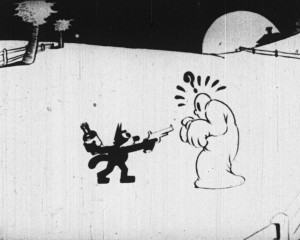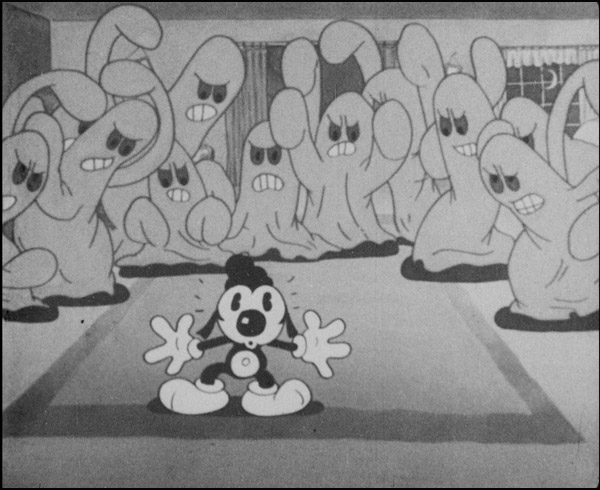
Some news on the Thunderbean video releases:
 As October gets underway, I’m happy to report some projects finally wrapping up. Abbott and Costello is getting it’s spit and polish this week and will hopefully be off to replication before too long. The rest of the Flip the Frog sneak previews are being sent, along with a handful of straggler orders going overseas, some things that somehow didn’t make it to people. Most folks should have these within the week.
As October gets underway, I’m happy to report some projects finally wrapping up. Abbott and Costello is getting it’s spit and polish this week and will hopefully be off to replication before too long. The rest of the Flip the Frog sneak previews are being sent, along with a handful of straggler orders going overseas, some things that somehow didn’t make it to people. Most folks should have these within the week.
Some more films arrived this week for transfer, and the new batch is especially interesting stuff. I really can’t wait to post stills from these completely forgotten films.
Since it’s the season, we’ve put together a ’Special’ but really unofficial Thunderbean set of Spooky Cartoons called “Halloween Rarities”. It’s a Blu-ray (BDR) that includes Toby the Pup in Halloween, rare Felix the Cat shorts (including some you really have never seen), a Sam Bassett cartoon (!) and lots and lots of worthwhile surprises. There’s 14 films in total. Since it’s close to Halloween, it’s only available for sale for a week – and we’re only making 150 of these. We’ll be sending them next Thursday. Details can be found here on the Thunderbean Website.

OLD MANOR HOUSE (1948)
Now, onto a Haunted House themed short that’s pretty puzzling: Old Manor House (1948). For many years, I had only seen this cartoon in black and white. That print has been a mainstay of the yearly Halloween cartoon showings that I did for over 20 years at my mother’s house on often rainy Halloween nights.
 It’s a “Bubble & Squeek” cartoon. There were only five cartoons made in the George Moreno series, with this one being my favorite. I’ve had a really unrunnable, brittle nitrate 35mm print of most of the cartoon for many years as well.
It’s a “Bubble & Squeek” cartoon. There were only five cartoons made in the George Moreno series, with this one being my favorite. I’ve had a really unrunnable, brittle nitrate 35mm print of most of the cartoon for many years as well.
Moreno, an animator who worked at Lantz and Fleischer’s in the 30s and early 40s, directed the series at his small studio in London. He went on to direct commericals for British Television, produced comics and other things is his long career. He also appears to have worked back in the states on a few shows, but for the most part lived in London after the war.
I find the animation, comic timing and even the music really bizarre in these shorts. Sometimes the gags,posing and timing are really fun; at other times they’re just strange! I always wondered if Joe Oriolo based ‘The Professor’ in the Felix cartoons on Colonel Rat.
Here’s a neat little article about Moreno, on the Bear Ally Blog. If you read the comments, there’s a great note from someone who worked at the studio in the late 60s.
There were five shorts made in this series of films before financial conditions (and competition) intruded in one way or another. Three of the shorts starred ‘Bubble and Squeek’ – a taxi driver and his cab. The last few shorts starred ‘Colonel Rat and Willie the Worm’. Old Manor House is my favorite of the, and a good kick off for Halloween month. Here’s a decent color print (although at least a few VHS generations down).
British Pathe has a neat cllp that shows the making of the Bubble and Squeak cartoon Fun Fair:
Have a good week everyone!


 Steve Stanchfield is an animator, educator and film archivist. He runs Thunderbean Animation, an animation studio in Ann Arbor, Michigan and has compiled over a dozen archival animation DVD collections devoted to such subjects at Private Snafu, The Little King and the infamous Cubby Bear. Steve is also a professor at the College for Creative Studies in Detroit.
Steve Stanchfield is an animator, educator and film archivist. He runs Thunderbean Animation, an animation studio in Ann Arbor, Michigan and has compiled over a dozen archival animation DVD collections devoted to such subjects at Private Snafu, The Little King and the infamous Cubby Bear. Steve is also a professor at the College for Creative Studies in Detroit.






















Looking forward to seeing Toby and Felix on Blue Ray ! Order up 🙂
Ha! That YouTube video of “Old Manor House” was posted by me (along with the studio’s other four cartoons) a few years back. As surmised, it was sourced from a VHS tape of dubious provenance called “British Animation No.2” from Loonic Video that I got from the public library. The quality is pretty wretched; at some points it’s so dark you can barely tell what’s going on.
Britain at the time was still in postwar recovery mode. I think I heard somewhere that Moreno tried as much as possible to staff his studio with war vets. There wasn’t a lot of seasoned talent available – I like to think he just handed out copies of Preston Blair’s “Animation” to everyone and let them sink or swim. That could account for the clumsy timing in these shorts.
Some other YouTuber put up a traced / colorized version of one of these titles, “Big City” – now that’s just nuts seeing as how it was produced in color to begin with!
Britain at the time was still in postwar recovery mode. I think I heard somewhere that Moreno tried as much as possible to staff his studio with war vets. There wasn’t a lot of seasoned talent available – I like to think he just handed out copies of Preston Blair’s “Animation” to everyone and let them sink or swim. That could account for the clumsy timing in these shorts.
It wouldn’t surprise me. According to the Bear Alley blog, this was during a time when there was a tax on American imports, leading I suppose to more domestic projects such as Moreno’s cartoons to be made at all. The same era also saw the production of Gaumont British Animation’s Musical Paintbox and Animaland series as produced by former Disney animator David Hand, which perhaps fared a little better in the long run, though lacking in other ways.
Some other YouTuber put up a traced / colorized version of one of these titles, “Big City” – now that’s just nuts seeing as how it was produced in color to begin with!
That was done through Fred Ladd’s “Radio & TV Packagers” outfit, which outsourced B&W dupe prints of all kinds to a studio in Korea that reanimated those in color, some that were silent were given needledrop tunes, often from the KPM “Green Label” library.
Library cues used in those redrawns were also sourced from the Conroy, Southern, and JW Theme Music libraries.
Are the Halloween / spooky cartoons on the Blu-Ray restored? Any chance you’ll give us a listing of all 14 shorts? 🙂
Hey, that “making of” is from playlist! Thanks, Steve.
Actually, the first four cartoons starred “Bubble and Squeak”. Colonel Rat first appeared in the fourth one – “Old Manor House” and was spun off in the fifth.
I can’t believe the studio couldn’t afford animation discs. I wonder why.
Could be they were unattainable at the time in the UK (if they had to import them from America). Looks like they used pegbars at least.
Moreno’s problem, from the start, was getting a distribution deal. Cartoons, although popular, were not a regular staple of cinema programmes and were more commonly relegated to Saturday Matinees and Newsreel Theatres. Distributors had plenty of US product at their disposal and were simply not prepared to pay enough to support British production. Moreno’s business plan was based on achieving a distribution deal for 6 films, but this proved very hard
Moreno produced the first film, “Big City”, on spec in order to have something to sell, but could find no takers. It appears that the subsequent distribution of the film by British Lion was a one-off favour – possibly in return for Moreno’s company (British Animated Productions) investing in the live-action second feature ghost story “Night Comes Too Soon” (aka Ghost of Rashmon Hall”). Eventually Pathé showed an interest, but it took 6 months to arrive at a contract compromising between what Moreno needed and Pathé were prepared to pay. Moreno was never prepared to give up, and continued producing the cartoons in anticipation of finally succeeding in getting a deal.
The Pathé Newsreel item on the making of “Fun Fair” was probably shot in late October 1948. It was shown in the Newsreel released 15 November 1948, to support the release of the actual cartoon. (The 3rd film, “Old Manor House” had been released on 29 October; “Fun Fair”, which was the 2nd film completed, was released on 11 November – I suspect the release dates were reversed in order to accommodate the Newsreel item.
“Fun Fair” had been completed by the beginning of June 1947, 17 months before the “Making Of…” newsreel. Hence such anomalies as the “Storyboard” actually being made up of cels from the finished production.
I think that the Studio had switched from the 2-peg registration used on “Fun Fair” to the 3-peg Acme system in the summer of 1948, which might explain the use of an old pegged board in the clip, for the purposes of continuity.